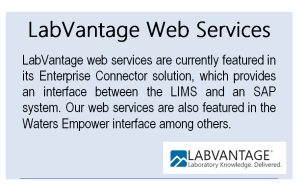 Several years ago, Gartner – the world’s leading research and advisory company – published a guide to enterprise quality management hubs, EQM Hubs Unite Quality Management IT Systems Across the Value Chain.
Several years ago, Gartner – the world’s leading research and advisory company – published a guide to enterprise quality management hubs, EQM Hubs Unite Quality Management IT Systems Across the Value Chain.
In this guide, the Gartner analysts cited the risks that occur when “critical manufacturing events aren’t sensed and responded to in a timely manner.” They warned this could result in “long-term damage to assets, brand, and even loss of human life.”
Notably, one approach they recommended to reduce this risk is to use immediate and automated services such as web services.
Web Services Enable Integration
As the main transactional language of the internet, web services are everywhere. As an example, LabVantage provides OOB support for REST and SOAP-based (Axis and JAX) web services. These allow external instruments, applications and systems to make secure calls to the LabVantage system and return data, insert data, and configure the system. RESTful web services, the most modern version of this technology, integrate especially easily with other systems.
 Choosing the Right Web Services Program
Choosing the Right Web Services Program
The right web services program can save you significant time, effort and money. For example, imagine that your enterprise resource planning (ERP) system needs to create batches and samples within the LIMS for testing, and have the results returned. Rather than taking the time and expense to build a completely custom interface, Web services enable the system to exchange messages and create the batches and samples needed – and even return the results to the external system. Web services are an essential tool bringing together your laboratory – and enterprise – informatics systems.
LabVantage handles this by making web services a core application programming interface (API) within the system, where all transactions use the core business logic to create and return values, create audit trails when necessary, properly associate child records, and conduct other required tasks.
Capable LIMS Web services should enable you to:
· Create or update a batch with all related details
· Create or update a sample with all associated testing
· Add more testing to an existing test
· Create an array or plate
· Add notes to a batch, sample or test
· Generate a label or report
· Change custody of a sample
· Read data from a file
· Receive a package for testing
· Send a bulletin to users
· Release a set of data when testing is complete
· Perform data approval
· Query information on LIMS objects (samples, batches, etc.), including primary data fields, metadata, status of testing or disposition, and more.
Focus on Comprehensive Security
Because many of these operations would require system authentication and permission before being performed, strong LIMS web services should include comprehensive web service security. Encrypted network protocols must be required, as well as permission by the user, filtering of permissible web service operations, and various other data security measures to safeguard your data and online operations.
These are just some of the critical issues to consider when evaluating how your LIMS solution addresses and embraces the use of web services.



